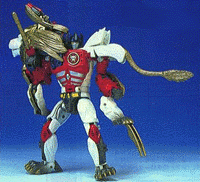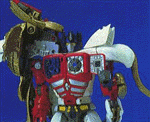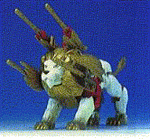 BEAST
WARS: TOY REVIEW
BEAST
WARS: TOY REVIEW
Name: LIO CONVOY (say "Lie-Oh" Convoy)
Allegiance: Cybertron
Function: Supreme Commander
Beast Mode: Lion
Average Price: 2980 JPY

BEAST MODE
Length: 15 cm (not including tail)
Height: 12 cm
A very well moulded white lion. The general sculpting is excellent, with particular attention paid to the face, fur and mane. In this mode, Lio Convoy is essentially a white lion with golden mane, tail and claws and gray accents on the feet. The eyes actually have eyeballs too! Also, pressing a button on the top the mane (which is moulded to blend in with the rest of the mane, so it doesn't really stick out) toggles the jaw, exposing fangs and teeth. The toy kinda reminds me of Jungle Taitei (aka "Kimba the White Lion"). The major drawback with this mode is that the underbelly reveals too many robot parts.
TRANSFORMATION TO ATTACK MODE
This is an intermediate mode. It basically involves opening up the lion's
mane, sticking on some missile launchers and flicking out some large blades
from the fore-legs. The mane also opens up like a flower and spins around.
I can't see why Lio Convoy would need this in battle (unless he causes lots of turbulence like in the show... cough), but it's a groovy
gimmick nonetheless.
TRANSFORMATION TO ROBOT MODE
Twist and turn the hind legs to form robot legs (similar to Cheetor, but a bit trickier). Open up the mane and swing front legs down to the side to form robot arms. Now, the robot chest flips down, the mid section swings up and the robot head swings round. The waist turns so that the lion head is pointing to the right. The chest flips up again and the arms lock in with the shoulders.
ROBOT MODE
Height: 20 cm
This mode looks pretty cool. The head is sculpted to look very much like the old G1 Convoy with the colour scheme being indentical except for two additional "antennae" which are gray (like
in the original Optmus Primal). The lion mane can again go into "sunflower" mode and spin. The mane missile launchers can also be attached, or you can put them into the fists for Lio Convoy to use as pistols. The lion fore legs can be swung forward from under the forearm with the blades protruding. There is also a button located on the inner forearms which flip
open the outer forearm panels, which in turn reveal two additional missile launchers! This gives Lio Convoy a very cool "armed to da teeth" look. I count over 20 points of articulation (including the forearm weapons). One drawback with this mode is the lion head. It rests above the right shoulder and is a bit bulky and cumbersome. It shifts a lot of weight over to the right side of the robot (thus creating some problems with
posing it). It also interferes with the movement of the right arm. Another is the way the durability. Nothing really securely locks into place in the torso section, so the chest has a tendency to flip open when you don't want it to. This gets really annoying during play.

THE TOUCH
"We are Primus, We are Prima, We are
Prime Nova, We are Sentinel Prime, We are Optimus Prime, We are..... THE
CREATION MATRIX!"
Well... sorta. Lio Convoy's left chest panel opens up to reveal a Matrix. However, unlike Big Convoy's Matrix, Lio Convoy's is part of the actual chest mould, which means that it doesn't come out. It just sits there and looks pretty. It's not a separate accessory like Big Convoy's Matrix.
RUB STICKER LOCATION
On the inside of the left breast panel in robot mode (the one that opens up).
OVERALL
A great looking toy and a recommended collector's piece, but the playability is slightly inhibited by the weak torso formation.

BEAST TRIVIA
Lions ('Panthera Leo') are the second largest members of the feline family in the world, with only the tiger physically larger. Male lions weigh on average 189 kilogrammes while female lions weigh 126 kilogrammes. Lions are tan in colour and have a slightly white under-body, with a tuft of black hair at the end of their tails.
Male lions are typically 1.2 metres in height, with a large mane of hair that begins to develop around age two that surrounds the neck. The mane can vary in colour from tawny/tan to black.
Females are 1.1 metres in height, and have no mane around their neck. Cubs are born with a slightly spotted coat, that changes to their parents tawny colouration around three months of age. Female lions live longer than males, and Serengeti female lions can live up to age 18, whereas males typically live up to age 12.
Lions are the only 'social' cats, whereby related female lions live together and form groups called 'prides'. Lion prides are family groups with all of the females related, mothers and daughters, sisters and cousins, etc.
A pride can range from three to 30 individuals, but tend to average about fifteen members, which include male and female lions plus a number of cubs. The number of lions in a pride will vary significantly based on the number of prey animals that live or migrate through the pride's territory.
A pride of lions will live in a territory that they will defend from other lions. Lions identify their territory by roaring loudly or by physically scent marking trees or rock outcrops. While female lions will hunt and kill most of the animals for the pride to eat, male lions are around primarily to defend the territory from other lion prides or nomadic male lions.
While female lions will live with the pride for life, male lions will only last two to four years before they are evicted or killed by a new coalition of male lions that take over the pride.
Male lions leave their pride of birth between the ages of two and four, and sets of male cubs born together will remain together throughout their lives. Male coalitions are not always blood relatives since males can team up with other independent males during their nomadic years. Nearly two-thirds of all male pairs and nearly half of all trios contain unrelated partners.
Large male coalitions can always outcompete smaller male coalitions for taking over a pride of females, and such coalitions may include as many as nine males. Within the coalition however, it is every male for himself when a female comes into estrus. The consorting male stays close to the female for four or five days and warns off his male companions. Rarely does overt fighting break out between partners.
While male lions that form larger coalitions will be more successful in acquiring territory, the chances than an individual male lion will father offspring is not shared equally. Males only achieve equal mating success in pairs.
Male lions have an unconditional affection for their coalition partners, whether they are blood relatives or not. Males will always cooperate with each other in defending their territory and their pride from other intruding male lions. Even when members of a coalition are temporarily separated from each other, they will still defend their territory from intruders, even when they are outnumbered.
Females start breeding at age four, and can come into heat at any time of the year, however, prides tend to synchronise reproduction. This could be due to new male coalitions taking over the pride and the death of their previous litter of cubs. It is estimated that lions must copulate 3,000 times for every cub that survives to a year of age. Upon successful conception, the gestation period is 14 to 15 weeks (around 110 days). Females won't come into heat for another 20 to 30 months are a litter is born, however, if their cubs are killed, females can come into heat within four days of death of the cubs.
Cubs are born after a gestation period of 110 days, with female lions giving birth in a den site, typically located in a rock outcrop or in dense vegetation. A female will on average give birth to three cubs that are between 0.9 to 1.8 kg in weight. The cub's eyes open between three to eleven days of age, and begin walking at 10 to 15 days. When the cubs are between four to six weeks old, the mother brings them out to the rest of the pride. Births within the pride are often timed synchronously, so most cubs often end up being reared with other cubs in a "crèche". Cubs are nursed until they are 6 to 8 months old, however, they continue to be dependent on their mother until at least 16 months of age.
Lions are opportunists when it comes to feeding. They will scavenge from other predators that have killed an animal, or will hunt animals ranging in size from the large African buffalo to a small hare.
Based on observations conducted in the Serengeti from 1966 to 1991, seven species represented over 90 % of the diet of lions. They were: wildebeest, zebra, Thompson's gazelle, buffalo, warthog, kongoni (hartebeest), and topi.
Lions do not vary their hunting frequency of buffalo. Only large lion prides tend to hunt buffalo, and typically go after solitary bulls rather than stalk and take on a whole herd of buffalo.
Lions hunting in groups of two or more successfully catch prey approximately 30% of the time, whereas individual lions are successful on only 17% of their hunts.
Bibliography: The Lion Research Centre
Email
Back
 BEAST
WARS: TOY REVIEW
BEAST
WARS: TOY REVIEW


